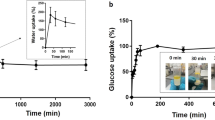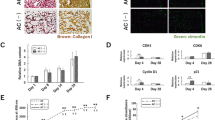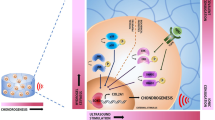Abstract
The culture of chondrocytes embedded within agarose hydrogels maintains chondrocytic phenotype over extended periods and allows analysis of the chondrocyte response to mechanical forces. The mechanisms involved in the transduction of a mechanical stimulus to a physiological process are not completely deciphered. We present protocols to prepare and characterize constructs of murine chondrocytes and agarose (1 week pre-culture period), to analyze the effect of compression on mRNA level by RT-PCR (2–3 d), gene transcription by gene reporter assay (3 d) and phosphorylation state of signaling molecules by western blotting (3–4 d). The protocols can be carried out with a limited number of mouse embryos or newborns and this point is particularly important regarding genetically modified mice.
This is a preview of subscription content, access via your institution
Access options
Subscribe to this journal
Receive 12 print issues and online access
$259.00 per year
only $21.58 per issue
Buy this article
- Purchase on Springer Link
- Instant access to full article PDF
Prices may be subject to local taxes which are calculated during checkout







Similar content being viewed by others
References
Fermor, B. et al. The effects of static and intermittent compression on nitric oxide production in articular cartilage explants. J. Orthop. Res. 19, 729–737 (2001).
Gosset, M. et al. Prostaglandin E2 synthesis in cartilage explants under compression: mPGES-1 is a mechanosensitive gene. Arthritis Res. Ther. 8, R135 (2006).
Xie, J., Han, Z.Y. & Matsuda, T. Mechanical compressive loading stimulates the activity of proximal region of human COL2A1 gene promoter in transfected chondrocytes. Biochem. Biophys. Res. Commun. 344, 1192–1199 (2006).
Quinn, T.M. et al. Mechanical compression alters proteoglycan deposition and matrix deformation around individual cells in cartilage explants. J. Cell Sci. 111 (Part 5): 573–583 (1998).
Fitzgerald, J.B. et al. Mechanical compression of cartilage explants induces multiple time-dependent gene expression patterns and involves intracellular calcium and cyclic AMP. J. Biol. Chem. 279, 19502–19511 (2004).
Sah, R.L. et al. Biosynthetic response of cartilage explants to dynamic compression. J. Orthop. Res. 7, 619–636 (1989).
Parkkinen, J.J., Lammi, M.J., Helminen, H.J. & Tammi, M. Local stimulation of proteoglycan synthesis in articular cartilage explants by dynamic compression in vitro . J. Orthop. Res. 10, 610–620 (1992).
Sauerland, K., Raiss, R.X. & Steinmeyer, J. Proteoglycan metabolism and viability of articular cartilage explants as modulated by the frequency of intermittent loading. Osteoarthr. Cartil. 11, 343–350 (2003).
Tomiyama, T. et al. Cyclic compression loaded on cartilage explants enhances the production of reactive oxygen species. J. Rheumatol. 34, 556–562 (2007).
Wong, M., Siegrist, M. & Cao, X. Cyclic compression of articular cartilage explants is associated with progressive consolidation and altered expression pattern of extracellular matrix proteins. Matrix Biol. 18, 391–399 (1999).
Buschmann, M.D., Gluzband, Y.A., Grodzinsky, A.J. & Hunziker, E.B. Mechanical compression modulates matrix biosynthesis in chondrocyte/agarose culture. J. Cell Sci. 108 (Part 4): 1497–1508 (1995).
Kelly, T.A. et al. Spatial and temporal development of chondrocyte-seeded agarose constructs in free-swelling and dynamically loaded cultures. J. Biomech. 39, 1489–1497 (2006).
Toyoda, T. et al. Hydrostatic pressure modulates proteoglycan metabolism in chondrocytes seeded in agarose. Arthritis Rheum. 48, 2865–2872 (2003).
Mauck, R.L. et al. Synergistic action of growth factors and dynamic loading for articular cartilage tissue engineering. Tissue Eng. 9, 597–611 (2003).
Chowdhury, T.T., Bader, D.L., Shelton, J.C. & Lee, D.A. Temporal regulation of chondrocyte metabolism in agarose constructs subjected to dynamic compression. Arch. Biochem. Biophys. 417, 105–111 (2003).
Benya, P.D. & Shaffer, J.D. Dedifferentiated chondrocytes reexpress the differentiated collagen phenotype when cultured in agarose gels. Cell 30, 215–224 (1982).
Tschan, T. et al. Resting chondrocytes in culture survive without growth factors, but are sensitive to toxic oxygen metabolites. J. Cell Biol. 111, 257–260 (1990).
Mallein-Gerin, F. et al. Analysis of collagen synthesis and assembly in culture by immortalized mouse chondrocytes in the presence or absence of alpha 1(IX) collagen chains. Exp. Cell. Res. 219, 257–265 (1995).
Bougault, C., Paumier, A., Aubert-Foucher, E. & Mallein-Gerin, F. Molecular analysis of chondrocytes cultured in agarose in response to dynamic compression. BMC Biotechnol. 8, 71 (2008).
Barlic, A. et al. Quantitative analysis of gene expression in human articular chondrocytes assigned for autologous implantation. J. Orthop. Res. 9, 9 (2008).
Huang, C.Y., Reuben, P.M. & Cheung, H.S. Temporal expression patterns and corresponding protein inductions of early responsive genes in rabbit bone marrow-derived mesenchymal stem cells under cyclic compressive loading. Stem Cells 23, 1113–1121 (2005).
Mauck, R.L., Byers, B.A., Yuan, X. & Tuan, R.S. Regulation of cartilaginous ECM gene transcription by chondrocytes and MSCs in 3D culture in response to dynamic loading. Biomech. Model. Mechanobiol. 6, 113–125 (2007).
Guilak, F. et al. The pericellular matrix as a transducer of biomechanical and biochemical signals in articular cartilage. Ann. NY Acad. Sci. 1068, 498–512 (2006).
Huang, A.H., Yeger-Mckeever, M., Stein, A. & Mauck, R.L. Tensile properties of engineered cartilage formed from chondrocyte- and MSC-laden hydrogels. Osteoarthr. Cartil. 16, 1074–1082 (2008).
Miyata, S., Tateishi, T. & Ushida, T. Influence of cartilaginous matrix accumulation on viscoelastic response of chondrocyte/agarose constructs under dynamic compressive and shear loading. J. Biomech. Eng. 130, 051016 (2008).
Knight, M.M., Lee, D.A. & Bader, D.L. The influence of elaborated pericellular matrix on the deformation of isolated articular chondrocytes cultured in agarose. Biochim. Biophys. Acta 1405, 67–77 (1998).
Gosset, M. et al. Mechanical stress and prostaglandin E(2) synthesis in cartilage. Biorheology 45, 301–320 (2008).
Lee, D.A. & Bader, D.L. Compressive strains at physiological frequencies influence the metabolism of chondrocytes seeded in agarose. J. Orthop. Res. 15, 181–188 (1997).
Frank, E.H. et al. A versatile shear and compression apparatus for mechanical stimulation of tissue culture explants. J. Biomech. 33, 1523–1527 (2000).
Mauck, R.L. et al. Functional tissue engineering of articular cartilage through dynamic loading of chondrocyte-seeded agarose gels. J. Biomech. Eng. 122, 252–260 (2000).
Aymard, P. et al. Influence of thermal history on the structural and mechanical properties of agarose gels. Biopolymers 59, 131–144 (2001).
Chen, Q., Suki, B. & An, K.N. Dynamic mechanical properties of agarose gels modeled by a fractional derivative model. J. Biomech. Eng. 126, 666–671 (2004).
Saris, D.B. et al. Dynamic pressure transmission through agarose gels. Tissue Eng. 6, 531–537 (2000).
Chomczynski, P. & Sacchi, N. The single-step method of RNA isolation by acid guanidinium thiocyanate–phenol–chloroform extraction: twenty-something years on. Nat. Protoc. 1, 581–585 (2006).
Mio, K., Kirkham, J. & Bonass, W.A. Tips for extracting total RNA from chondrocytes cultured in agarose gel using a silica-based membrane kit. Anal. Biochem. 351, 314–316 (2006).
Szuts, V. et al. Terminal differentiation of chondrocytes is arrested at distinct stages identified by their expression repertoire of marker genes. Matrix Biol. 17, 435–448 (1998).
Hoemann, C.D., Sun, J., Chrzanowski, V. & Buschmann, M.D. A multivalent assay to detect glycosaminoglycan, protein, collagen, RNA, and DNA content in milligram samples of cartilage or hydrogel-based repair cartilage. Anal. Biochem. 300, 1–10 (2002).
Wu, Y., Li, Q. & Chen, X.Z. Detecting protein–protein interactions by Far western blotting. Nat. Protoc. 2, 3278–3284 (2007).
Ghayor, C. et al. Regulation of human COL2A1 gene expression in chondrocytes. Identification of C-Krox-responsive elements and modulation by phenotype alteration. J. Biol. Chem. 275, 27421–27438 (2000).
Lefebvre, V. et al. Characterization of primary cultures of chondrocytes from type II collagen/beta-galactosidase transgenic mice. Matrix Biol. 14, 329–335 (1994).
Valcourt, U. et al. Functions of transforming growth factor-beta family type I receptors and Smad proteins in the hypertrophic maturation and osteoblastic differentiation of chondrocytes. J. Biol. Chem. 277, 33545–33558 (2002).
Gosset, M., Berenbaum, F., Thirion, S. & Jacques, C. Primary culture and phenotyping of murine chondrocytes. Nat. Protoc. 3, 1253–1260 (2008).
Salvat, C. et al. Immature murine articular chondrocytes in primary culture: a new tool for investigating cartilage. Osteoarthr. Cartil. 13, 243–249 (2005).
Pfaffl, M.W. A new mathematical model for relative quantification in real-time RT-PCR. Nucleic. Acids. Res. 29, e45 (2001).
Sambrook, J., Fritsch, E.F. & Maniatis, T. Detection and analysis of proteins expressed from cloned genes. In Molecular Cloning: A Laboratory Manual 2nd edn 18.19–18.74 (Cold Spring Harbor Laboratory Press, Cold Spring Harbor, New York, 1989).
Lee, J.H., Fitzgerald, J.B., Dimicco, M.A. & Grodzinsky, A.J. Mechanical injury of cartilage explants causes specific time-dependent changes in chondrocyte gene expression. Arthritis Rheum. 52, 2386–2395 (2005).
Li, K.W., Wang, A.S. & Sah, R.L. Microenvironment regulation of extracellular signal-regulated kinase activity in chondrocytes: effects of culture configuration, interleukin-1, and compressive stress. Arthritis Rheum. 48, 689–699 (2003).
Fanning, P.J. et al. Mechanical regulation of mitogen-activated protein kinase signaling in articular cartilage. J. Biol. Chem. 278, 50940–50948 (2003).
Nolan, T., Hands, R.E. & Bustin, S.A. Quantification of mRNA using real-time RT-PCR. Nat. Protoc. 1, 1559–1582 (2006).
Mayne, R. et al. Monoclonal antibody to the aminotelopeptide of type II collagen: loss of the epitope after stromelysin digestion. Connect. Tissue Res. 31, 11–21 (1994).
Acknowledgements
We thank Novotec (Lyon) for the generous gift of the anti-aggrecan antibody and the technical facilities of IFR 128 (BioSciences Gerland—Lyon Sud) for the quantitative PCR analyses. We are grateful to Karine Duroure for technical assistance. We also thank Professor Philippe Galéra (Caen University) for the gift of the p3 plasmid carrying a fragment of the human type II collagen gene promoter. This study was funded by Rhône-Alpes Region (Emergence 2005), ANR (TECSAN Promocart 2006), CNRS and the Lyon 1 University. C.B. was supported by the French Ministère de la Recherche.
Author information
Authors and Affiliations
Corresponding author
Rights and permissions
About this article
Cite this article
Bougault, C., Paumier, A., Aubert-Foucher, E. et al. Investigating conversion of mechanical force into biochemical signaling in three-dimensional chondrocyte cultures. Nat Protoc 4, 928–938 (2009). https://doi.org/10.1038/nprot.2009.63
Published:
Issue Date:
DOI: https://doi.org/10.1038/nprot.2009.63
This article is cited by
-
A high-resolution route map reveals distinct stages of chondrocyte dedifferentiation for cartilage regeneration
Bone Research (2022)
-
Investigations of Strain Fields in 3D Hydrogels Under Dynamic Confined Loading
Journal of Medical and Biological Engineering (2018)
-
Repair of articular cartilage defects in the knee with autologous iliac crest cartilage in a rabbit model
Knee Surgery, Sports Traumatology, Arthroscopy (2015)
-
Encapsulation of Chondrocytes in High-Stiffness Agarose Microenvironments for In Vitro Modeling of Osteoarthritis Mechanotransduction
Annals of Biomedical Engineering (2015)
-
Hyaluronic acid secretion by synoviocytes alters under cyclic compressive load in contracted collagen gels
Cytotechnology (2015)
Comments
By submitting a comment you agree to abide by our Terms and Community Guidelines. If you find something abusive or that does not comply with our terms or guidelines please flag it as inappropriate.



